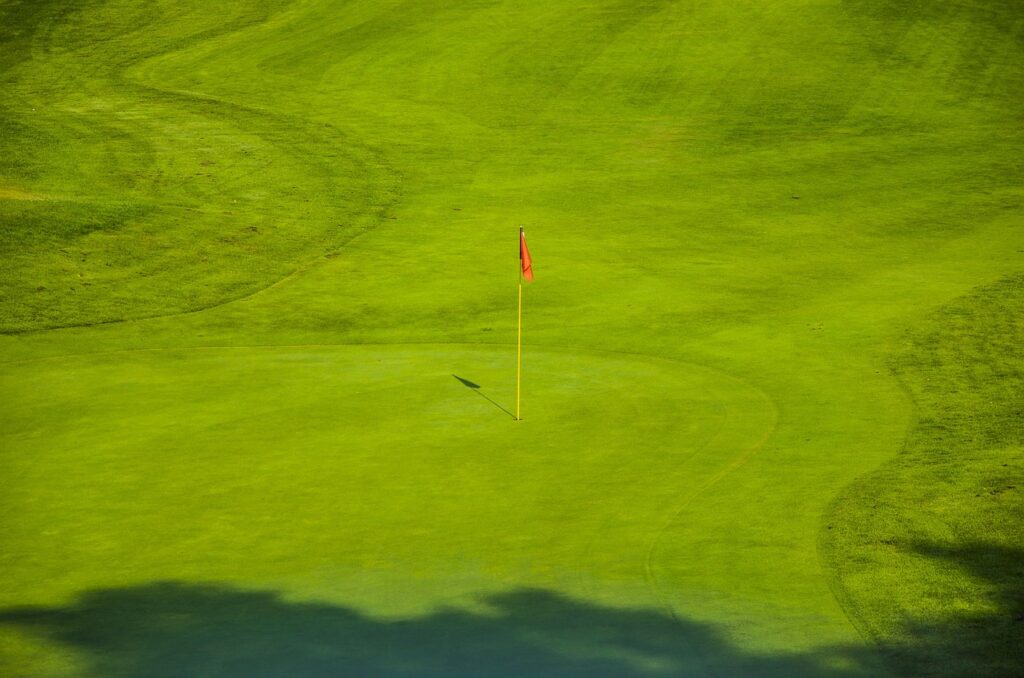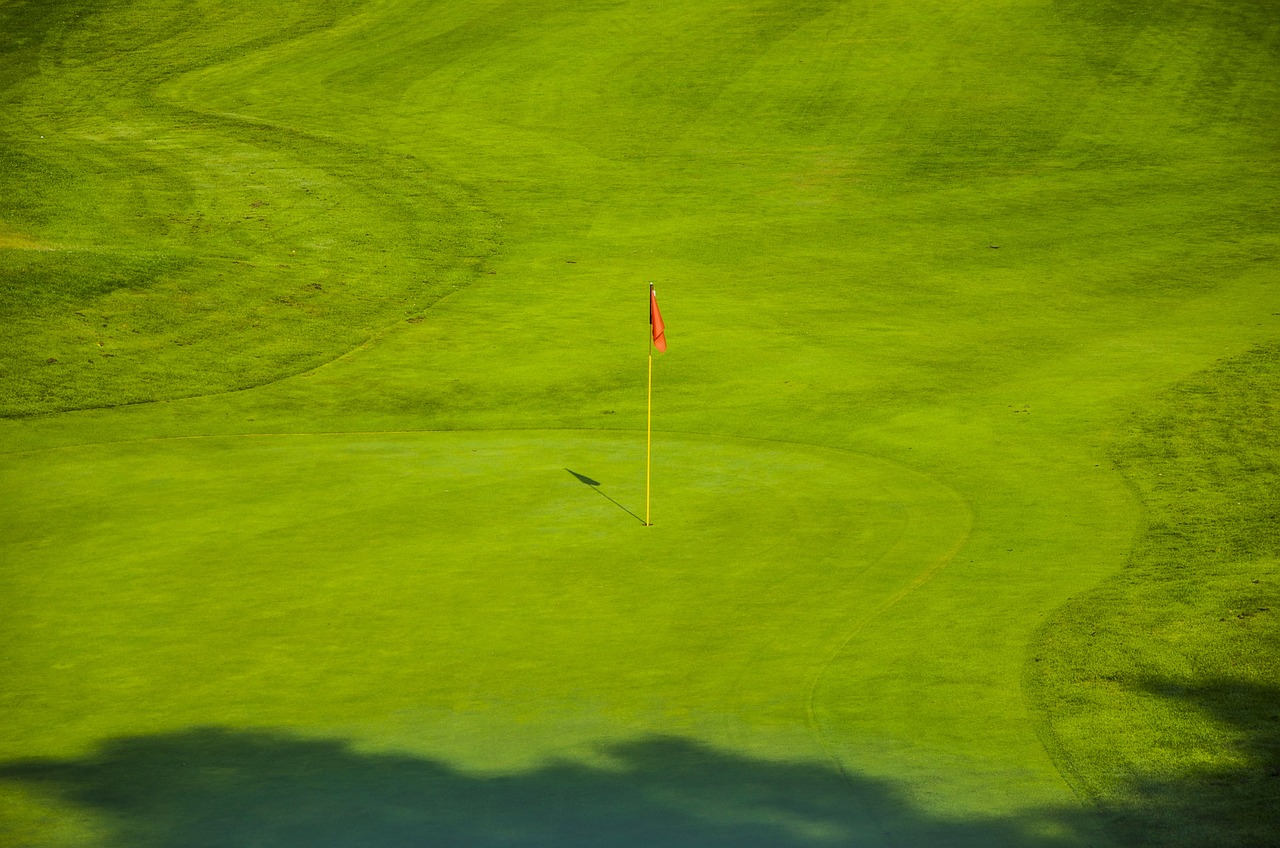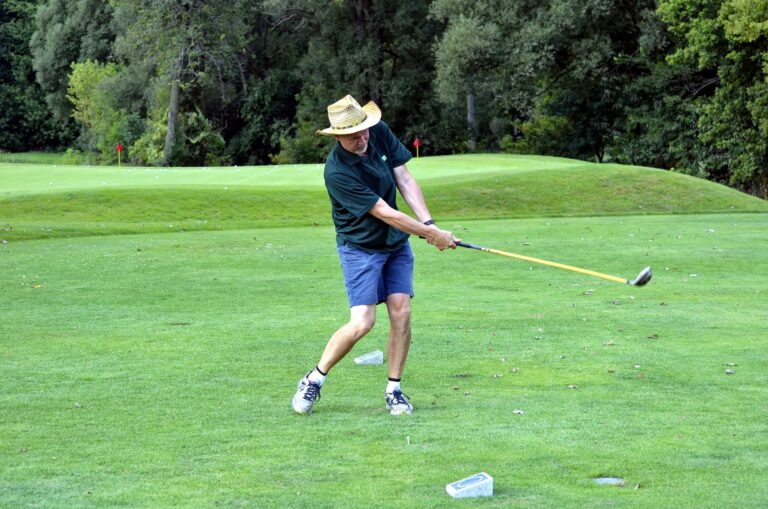how to read a golf green.
Hi golf lovers, in this post, I am going to share some incredible insight into how to read a golf green as this will help you make more accurate putts thereby lowering your scores.
Reading a golf green is one of the most crucial skills for any golfer, regardless of their skill level. This process involves analyzing the slope, grain, and speed of the green to determine how to putt the ball towards the hole.
At first, this may seem daunting but as time pass by and with constant practice, you may eventually be able to read the green like a pro.
To begin with, it is essential to study the green as you approach it. Take a close look at the slope and any visible undulations. It can be helpful to walk around the green to get a better understanding of its contours.
Once you are on the green, squat down behind your ball and look at the path the ball will need to take to get to the hole. This will give you a better idea of the slope and help you determine the best line to take.
Learning how to read a green takes time and practice, but it can significantly improve your golf game.
There are incredible benefits to understanding the slope, grain, and speed of the green, one of which is; you can make more accurate putts and lower your score. In the following sections, we will discuss some tips and techniques that can help you improve your green-reading skills.
how to read a golf green – Understanding Golf Green Basics

As I have stated above, reading a golf green is an essential skill that every golfer needs to get a hang of in other to improve their putting accuracy. A golf green is not a flat surface; it has slopes and contours that can affect the ball’s trajectory. Understanding the basics of the golf green can help a golfer make better judgments and improve their putting game.
Green Speed
The speed of the green is one of the essential factors to consider when reading a golf green. The speed of the green is determined by the length of the grass, the moisture level, and the contours of the green. A faster green requires a softer touch, while a slower green requires more force to get the ball to the hole. Golfers can get an idea of the green speed by observing the ball’s roll when it is hit on the green.
Slope
The slope of the green is another crucial factor to consider when reading a golf green. The slope can affect the ball’s trajectory and speed, making it challenging to get the ball to the hole. A golfer can determine the slope by observing the green from different angles and looking for any visible contours. It is essential to keep in mind that the slope may not be visible from the golfer’s position, so they may need to move around to get a better view.
Grain
The grain of the grass can also affect the ball’s trajectory and speed. The grain refers to the direction in which the grass grows on the green. A ball that is hit against the grain will roll slower and may veer off course, while a ball hit with the grain will roll faster and straighter. Golfers can determine the grain by observing the grass’s color and texture on the green.
By and large, understanding the basics of the golf green is essential for any golfer looking to improve their putting game. The speed, slope, and grain of the green are all factors that can affect the ball’s trajectory and speed.
Identifying the Type of Grass
When it comes to reading a golf green, it’s important to identify the type of grass on the green. Different types of grass have different textures, densities, and growth patterns, which can all affect how the ball rolls on the green. Here are some common types of grass found on golf greens:
Bermudagrass
Bermudagrass is a warm-season grass that is commonly found in the southern United States. It has a fine texture and is known for its ability to tolerate heat and drought. Bermudagrass greens are typically fast and firm, which can make them challenging to putt on.
Bentgrass
Bentgrass is a cool-season grass that is commonly found in the northern United States and Europe. It has a fine texture and is known for its ability to tolerate low mowing heights. Bentgrass greens are typically smooth and fast, which can make them ideal for putting.
Poa annua
Poa annua is a cool-season grass that is commonly found in the western United States. It has a coarse texture and is known for its ability to tolerate a wide range of temperatures and moisture levels. Poa annua greens are typically bumpy and can be difficult to putt on.
Zoysia grass
Zoysia grass is a warm-season grass that is commonly found in the southern United States and Asia. It has a medium texture and is known for its ability to tolerate heat and drought. Zoysia grass greens are typically slow and spongy, which can make them challenging to putt on.
To identify the type of grass on a golf green, golfers can look at the color, texture, and growth pattern of the grass. Golfers can also ask the course superintendent or a local turf expert for help in identifying the type of grass.
knowing the type of grass on the green can hep golfers better understand how the ball will roll and make more informed decisions when putting.
Assessing the Green’s Slope
When reading a golf green, the slope of the green is a crucial factor to consider. Identifying the high and low points and understanding the break direction can help a golfer accurately read the green and make successful putts.
Identifying the High and Low Points
To identify the high and low points of a green, golfers should walk around the green and observe the overall shape of the green. Typically, greens will have a high point and a low point. The high point is where water drains off the green, and the low point is where water collects.
Golfers can also use their feet to feel the slope of the green. Standing on the high point, the golfer should feel as though they are leaning downhill, while standing on the low point, they should feel as though they are leaning uphill.
Understanding Break Direction
Break direction refers to the direction that the ball will move as it rolls across the green. Golfers can determine the break direction by observing the slope of the green and the position of the hole.
If the hole is on a slope, the ball will break away from the slope. For example, if the slope is to the right of the hole, the ball will break left. If the slope is to the left of the hole, the ball will break right.
Golfers should also consider the speed of the green when determining break direction. Faster greens will have more break than slower greens, and uphill putts will break less than downhill putts.
Reading Green Speed
Reading green speed is an essential part of putting in golf. The speed of the green can significantly affect the line and distance of your putt. Therefore, it is crucial to understand the factors that affect green speed and how to judge it.
Factors Affecting Speed
Several factors can affect the speed of the green, including:
- Grass Type: Different grass types have different growth rates, which can affect the speed of the green. For instance, Bermuda grass is known for its fast growth, making it a popular choice for greens in warmer climates.
- Moisture: The amount of moisture on the green can affect its speed. A wet green will be slower than a dry one.
- Slope: The slope of the green can also affect its speed. A downhill slope will make the green faster, while an uphill slope will make it slower.
- Temperature: The temperature can affect the speed of the green. A hot day will make the green faster than a cold one.
How to Judge Speed
Judging the speed of the green requires experience and practice. Here are some tips to help you judge green speed:
- Walk the Green: Before putting, walk around the green and get a feel for its slope and any undulations. This will help you judge the speed of the green.
- Feel the Grass: Run your hand over the grass to get a sense of its moisture level. A dry green will be faster than a wet one.
- Watch Others: Watch other golfers putt to get a sense of the green’s speed. Pay attention to how far their ball rolls and how it breaks.
- Practice Putting: Practice putting on greens of varying speeds. This will help you develop a feel for how hard to hit the ball on different greens.
Observing Green Conditions
When it comes to reading a golf green, you want to observe the conditions of the green before making any putts.
Basically, there are two main factors that can affect the way a ball rolls on a green: weather conditions and green maintenance.
Effect of Weather Conditions
Weather conditions can have a significant impact on the way a ball rolls on a green. For example, if the green is wet due to recent rain or dew, the ball will likely roll slower and may even skid. On the other hand, if the green is dry and firm due to hot weather or lack of rain, the ball will likely roll faster and may even bounce.
Wind can also affect the way a ball rolls on a green. A headwind can slow the ball down, while a tailwind can speed it up. Crosswinds can cause the ball to curve and even change direction.
It’s important to take note of the weather conditions before making any putts and adjust accordingly. For example, if the green is wet, the golfer may need to hit the ball harder to compensate for the slower roll.
Impact of Green Maintenance
Green maintenance can also have a significant impact on the way a ball rolls on a green. If the green has been recently mowed, the ball will likely roll faster and smoother. However, if the green has not been mowed in a while, the ball may bounce or even veer off course.
The direction of the grain can also affect the way a ball rolls on a green. The grain refers to the direction in which the grass blades are growing. If the grain is against the direction of the putt, the ball will likely roll slower. If the grain is with the direction of the putt, the ball will likely roll faster.
Golfers should take note of the green maintenance before making any putts and adjust accordingly. For example, if the green has not been mowed in a while, the golfer may need to hit the ball softer to compensate for the slower roll.
Observing the conditions of the green is an essential part of reading the green and making accurate putts. By taking note of the weather conditions and green maintenance, golfers can adjust their approach and improve their chances of sinking the ball.
Using Aids to Read Greens
While some golfers rely on their instincts to read greens, others use aids to improve their green-reading skills. In this section, we will discuss two types of aids: golf apps and gadgets and traditional methods.
Golf Apps and Gadgets


Advancements in technology have brought about a wide range of golf apps and gadgets that can help golfers read greens more accurately. These tools use GPS and other sensors to provide golfers with real-time data on the slope, speed, and direction of the green.
One popular golf app that helps golfers read greens is the AimPoint Express app. This app uses a simple system to help golfers calculate the slope of the green and determine the correct aim point. The app also provides golfers with a visual representation of the green, which can help them visualize the break of the putt.
Another popular gadget that can help golfers read greens is the SlopeGraide Golf Green Reading Training Aid. This gadget uses a simple system to help golfers determine the slope of the green and the correct aim point. The SlopeGraide also provides golfers with a visual representation of the green, which can help them visualize the break of the putt.
Traditional Methods
While golf apps and gadgets can be helpful, some golfers prefer to use traditional methods to read greens. These methods include looking at the slope of the green, the direction of the grain, and the speed of the green.
One traditional method that golfers use to read greens is to walk around the green and look at it from different angles. This can help golfers get a better sense of the slope and the direction of the break.
Another traditional method that golfers use to read greens is to look at the grain of the grass. The grain of the grass can affect the speed and direction of the putt, so it is important to take it into account when reading greens.
In conclusion, there are many aids available to golfers to help them read greens more accurately. Golf apps and gadgets can be helpful, but some golfers prefer to use traditional methods. Ultimately, the best way to read greens is to practice and develop a feel for the green.
Practicing Green Reading
Practicing green reading is essential to improve a golfer’s performance. Here are some tips to help golfers improve their green reading skills:
Walk around the green: Walking around the green can help golfers understand the slope and the breaks on the green. Golfers should walk to the high point of the green and observe the slope to the hole. They should also walk to the low point of the green and observe the slope from that point.
Use a putting aid: Using a putting aid can help golfers understand the slope and the breaks on the green. Golfers can use a device that helps them read the slope and breaks on the green. One such device is the AimPoint Express, which uses a numbering system to help golfers read the slope and breaks on the green.
Practice putting from different angles: Golfers should practice putting from different angles to get a better understanding of the slope and breaks on the green. They should practice putting from uphill, downhill, and sidehill lies. This will help them develop a feel for the slope and breaks on the green.
Read the green from different distances: Golfers should practice reading the green from different distances. They should observe the slope and breaks on the green from a distance and then get closer to the green to get a better understanding of the slope and breaks.
Practice with a partner: Practicing with a partner can help golfers improve their green reading skills. Golfers can take turns reading the green and observing the slope and breaks. This will help them develop a better understanding of the green and the slope and breaks on the green.
Common Mistakes to Avoid
By now I am sure you know how important a skill it is to know how to read golf green.
The problem however is, many golfers make some common mistakes that can negatively impact their performance. Here are some of the most common mistakes to avoid when reading golf greens:
1. Not Walking Around the Green
One of the most common mistakes that golfers make is not walking around the green before approaching their ball. Walking around the green allows golfers to get a better understanding of the slope and contours of the green. This information is crucial when it comes to determining the speed and direction of the putt.
2. Not Taking Note of the Grain
Another mistake that golfers make is not taking note of the grain of the grass. The grain refers to the direction in which the grass is growing. If the grass is growing towards the golfer, the ball will roll slower, and if it’s growing away, the ball will roll faster.
It is essential to take note of the grain because it can significantly affect the speed and direction of the putt.
3. Not Considering the Surrounding Terrain
Golfers often make the mistake of not considering the surrounding terrain when reading golf greens. The surrounding terrain, such as bunkers, hills, and water hazards, can significantly affect the slope and contours of the green. It’s important to take note of these features and how they can impact the putt.
4. Not Taking Enough Time
Lastly, golfers often make the mistake of not taking enough time when reading golf greens. Rushing the process can lead to misreading the green and making the wrong decision. It’s crucial to take the time to walk around the green, assess the slope and contours, and consider all the surrounding terrain before making a decision.
Rounding up, avoiding these common mistakes can significantly improve a golfer’s putting accuracy. By taking the time to walk around the green, consider the grain, surrounding terrain, and taking enough time, golfers can make more informed decisions and improve their overall performance on the green.
Frequently Asked Questions
How do I use AimPoint green reading chart to read a golf green?
The AimPoint green reading system is a popular technique used by professional golfers to read greens. To use the AimPoint green reading chart, a player needs to stand behind the ball and align the chart with the slope of the green.
The chart is designed to help golfers determine the slope and direction of the putt. The player then uses this information to adjust their aim and speed to make the putt.
What are the different techniques to read a golf green?
There are several techniques to read a golf green, including the AimPoint system, the slope method, the plumb-bob method, and the grain method. Each method has its own advantages and disadvantages, and golfers should choose the one that works best for them.
Can I read the grain on a golf green with my feet?
Yes, it is possible to read the grain on a golf green with your feet. By walking around the green, golfers can feel the direction of the grain and determine how it will affect the speed and direction of their putt.
Which is the best green reading system for golf?
There is no one-size-fits-all answer to this question, as each golfer has their own preferences and strengths. However, the AimPoint system is a popular choice among professional golfers, and many amateurs have found success using this technique as well.
Are there any golf green reading apps available?
Yes, there are several golf green reading apps available for download on smartphones and tablets. These apps use GPS technology to provide golfers with detailed information about the slope and contour of the green.
What do the numbers on a golf green signify?
The numbers on a golf green signify the slope and contour of the green. A lower number indicates a flatter surface, while a higher number indicates a steeper slope. Golfers can use this information to adjust their aim and speed to make the putt.
Conclusion

One important thing to keep in mind is that reading the green is not an exact science. The slope, grain, and grass type can vary from green to green, and even from day to day. Therefore, golfers should always take the time to study the green before making their putt, and adjust their approach accordingly.
Another important factor to consider is the speed of the green. Golfers should pay attention to the speed of the green and adjust their putting speed accordingly. A putt that is hit too hard or too soft can easily miss the hole, even if it’s read correctly.
In conclusion, reading a golf green is a skill that can take time and practice to master. However, by following the tips and techniques outlined in this article, golfers can improve their putting accuracy and lower their scores on the course.







